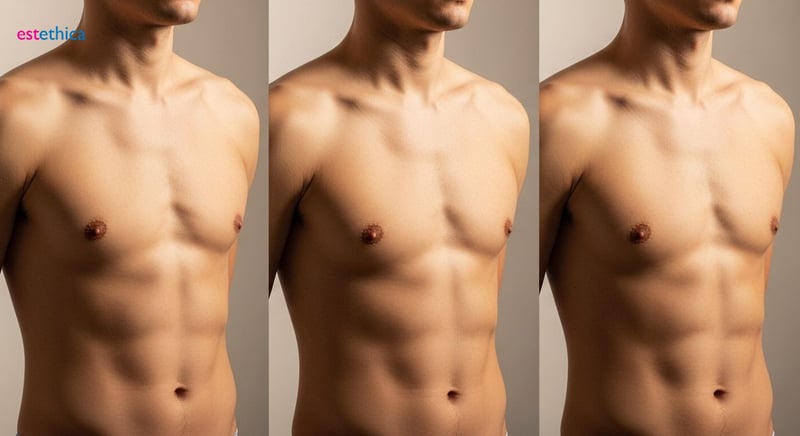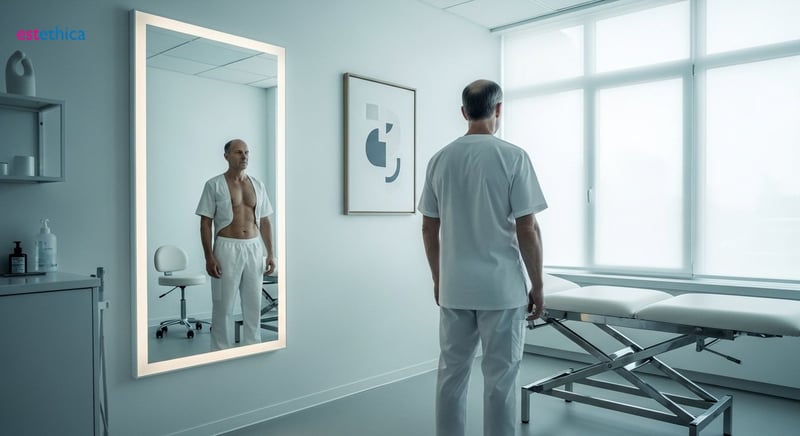Gynecomastia: Reclaim Your Chest with Male Breast Reduction
Gynecomastia surgery offers a pathway to regain confidence by achieving a more masculine chest contour. Learn more about its benefits and how to find the best surgeon.
Gynecomastia affects many men worldwide, causing physical discomfort and impacting self-esteem. Through male breast reduction surgery, individuals can reclaim confidence with more traditionally masculine chest contours. This article will guide you through understanding gynecomastia, differentiating it from chest fat, and exploring treatment options.
What is Gynecomastia and What Causes Enlarged Male Breasts?
Understanding Gynecomastia and Its Impact
Gynecomastia, characterized by the enlargement of breast tissue in males, stems from a hormonal imbalance where estrogen levels surpass those of testosterone. This condition can manifest at various stages of life, most notably during puberty in adolescents. While often a temporary phase in younger individuals, gynecomastia can persist into adulthood, influenced by a range of factors including underlying medical conditions, medication side effects, and lifestyle choices. A nuanced understanding of these root causes is critical, not only for distinguishing gynecomastia from the accumulation of male chest fat (sometimes referred to as pseudogynecomastia) but also for guiding individuals toward the most appropriate and effective treatment strategies. This differentiation ensures that treatments are tailored to address the specific nature of the breast enlargement.
Common Factors Contributing to Gynecomastia
- Hormonal Imbalance: The primary culprit, where estrogen levels are disproportionately higher than testosterone. This imbalance can be triggered by various conditions or external factors.
- Medications: Certain drugs, including anabolic steroids, anti-androgens, and some antidepressants, can disrupt the hormonal balance, leading to the development of gynecomastia.
- Lifestyle Factors: Excessive alcohol consumption and the use of illicit drugs like marijuana have been linked to hormonal imbalances that may contribute to enlarged male breasts.
Identifying the specific cause of gynecomastia is a crucial step in determining the most effective treatment approach, whether it's through medication, lifestyle adjustments, or surgical intervention like male breast reduction.
Distinguishing Gynecomastia from Other Conditions
Accurate diagnosis is essential in addressing concerns about enlarged male breasts. It is important to differentiate true gynecomastia, which involves the growth of glandular tissue, from pseudogynecomastia, where excess fat accumulates in the chest area. Conditions like male chest fat may present similarly but require different treatment approaches. For instance, while gynecomastia often necessitates hormonal treatment or surgery to remove glandular tissue, excess male chest fat might be addressed through diet, exercise, or liposuction for men. A thorough medical evaluation, possibly including a physical exam and hormone level assessments, is vital. Such evaluation ensures that individuals receive the most appropriate intervention, aligning treatment with the precise underlying cause of their condition.
Diagnostic Steps for Identifying Gynecomastia
- Physical Examination: A doctor will manually examine the breast tissue to determine if there is rubbery or firm glandular tissue, which is characteristic of gynecomastia.
- Hormone Level Assessment: Blood tests may be ordered to check the levels of testosterone and estrogen, helping to identify hormonal imbalances.
- Medical History Review: Evaluating the patient's medical history, including medication use and existing health conditions, to pinpoint potential causes.
This multi-faceted approach helps in accurately diagnosing Gynecomastia and differentiating it from other conditions.

Male Chest Fat vs. Gynecomastia: Understanding the Difference
Differentiating Male Chest Fat from Glandular Gynecomastia
Distinguishing between male chest fat (pseudogynecomastia) and true gynecomastia is essential for proper treatment. While both conditions result in the appearance of enlarged male breasts, their underlying causes differ significantly. Male chest fat, or pseudogynecomastia, results from the accumulation of fatty tissue in the chest area, often associated with obesity or weight gain. On the other hand, gynecomastia involves the growth of glandular breast tissue, typically due to hormonal imbalances. A clinical examination can often reveal the difference; glandular tissue feels firm and rubbery, while chest fat feels softer and more diffuse. In some cases, imaging studies like ultrasound may be necessary to confirm the diagnosis and guide appropriate management strategies.
Key Differences Between Male Chest Fat and Gynecomastia
- Tissue Composition: Gynecomastia involves the growth of glandular tissue, while male chest fat consists primarily of adipose tissue.
- Primary Causes: Gynecomastia is usually caused by hormonal imbalances, whereas male chest fat is often linked to obesity or weight gain.
- Physical Examination: Gynecomastia presents as a firm, rubbery tissue mass around the nipple, while male chest fat feels softer and more widespread.
Accurate diagnosis is crucial because the treatment approach differs significantly for gynecomastia and male chest fat. For example, a man who experiences a significant weight loss journey may find that, despite his efforts, he is still bothered by excess chest fat, which, unlike gynecomastia, won't resolve with hormonal treatments.
Diagnostic Methods to Distinguish Between Conditions
To accurately distinguish between male chest fat and gynecomastia, healthcare providers employ various diagnostic methods. The process typically begins with a thorough clinical examination, where the doctor palpates the chest area to assess the texture and consistency of the tissue. If the diagnosis remains unclear, further investigation may involve imaging studies such as ultrasound or mammography. These techniques can help visualize the underlying tissue composition and identify the presence of glandular tissue characteristic of gynecomastia. Hormone level assessments through blood tests may also be conducted to evaluate hormonal imbalances that contribute to the condition. Employing this multifaceted approach ensures an accurate diagnosis, allowing for the development of an effective treatment plan tailored to the individual's specific needs. For instance, a teenager experiencing chest enlargement may undergo these tests to determine if it's a temporary, puberty-related gynecomastia or a case of excess chest fat due to lifestyle factors.
Steps in Diagnostic Evaluation
- Palpation of Chest Tissue: Feeling the chest to identify the texture and presence of glandular or fatty tissue.
- Imaging Studies: Using ultrasound or mammography to visualize tissue composition.
- Hormone Level Testing: Assessing hormone levels via blood tests to check for imbalances.
These detailed evaluations offer comprehensive information for diagnosing and differentiating accurately between the two conditions.

Gynecomastia Surgery: Before and After Transformations Revealed
Visualizing Transformation: The Impact of Gynecomastia Surgery
Gynecomastia surgery can significantly transform a man's physique and self-confidence by removing excess glandular tissue and fat. Before and after photos serve as powerful tools, offering prospective patients a realistic glimpse into the potential outcomes of the procedure. These images showcase the reduction of enlarged male breasts, resulting in a flatter, more contoured chest. Such visual evidence is invaluable for setting realistic expectations and assuring patients about the effectiveness of surgical intervention. For instance, viewing before and after shots helps individuals understand how the procedure addresses concerns related to enlarged male breasts, ultimately aiding them in making informed decisions about pursuing surgical correction.
Key Aspects Highlighted in Before and After Photos
- Chest Contouring: The photos illustrate the change in chest shape, showcasing a flatter, more masculine contour achieved post-surgery.
- Nipple Placement: Before and after images reveal how the procedure corrects nipple projection and placement for a natural appearance.
- Scar Visibility: The images provide insight into the potential visibility of scars, helping patients understand what to expect during the healing process.
Esthetica Global aims to provide before and after visualization, focusing on chest contouring, nipple placement, and scar visibility.
Understanding Surgical Techniques and Expected Outcomes
The effectiveness of gynecomastia surgery relies not only on the surgeon's skill but also on the specific techniques employed. Different surgical approaches, such as liposuction, excision, or a combination of both, cater to varying degrees of gynecomastia. Before and after photos often highlight the results achieved with each technique, allowing patients to appreciate the nuances of each approach. For example, liposuction may be sufficient for cases involving predominantly fatty tissue, while excision becomes necessary when significant glandular tissue needs removal. By examining these visual examples, patients can gain insights into which technique might be most appropriate for their particular condition, facilitating more informed discussions with their surgeons. This visual understanding is particularly beneficial for individuals seeking male breast reduction.
Gynecomastia Surgical Techniques and Expected Outcomes
- Liposuction: Ideal for removing excess male chest fat, resulting in a smoother chest contour. Patients often see a significant reduction in chest size with minimal scarring.
- Excision: Used to remove glandular tissue, providing a more defined and masculine chest appearance. This technique addresses cases of true gynecomastia effectively.
- Combination: Combines liposuction and excision for optimal results, addressing both excess male chest fat and glandular tissue to achieve a natural-looking chest.
These surgical techniques offer specific solutions tailored to the individual needs of each patient. Esthetica Global's before and after photos for demonstrating surgical techniques that can help patients understand expected outcomes.

Finding the Best Doctor for Gynecomastia Surgery: Your Guide
Essential Credentials and Expertise for a Gynecomastia Surgeon
Selecting a highly qualified and experienced surgeon is critical for achieving successful outcomes in gynecomastia surgery. Key factors to consider include the surgeon's board certification in plastic surgery or a related field, along with specific training and a proven track record in performing male breast reduction. It's important to verify these credentials through respected medical boards. A surgeon with extensive experience is more likely to adeptly handle the nuances of the procedure, manage potential complications, and deliver results that align with the patient's aesthetic goals. Moreover, understanding the surgeon's continuous education in the latest surgical techniques ensures they offer the most advanced and effective treatments available, catering to individual patient needs for enlarged male breasts.
Key Indicators of a Qualified Surgeon
- Board Certification: Look for certification from recognized boards in plastic surgery or a similar specialty.
- Extensive Experience: Verify the surgeon’s history of performing gynecomastia surgeries, focusing on their success rates and patient satisfaction.
- Specialized Training: Ensure the surgeon has specific training in the latest techniques for male breast reduction.
Always prioritize surgeons who demonstrate a commitment to excellence and patient safety throughout their practice.
Assessing Patient Outcomes and Surgeon Alignment with Goals
Reviewing before-and-after photos of previous patients is an invaluable step in evaluating a surgeon's aesthetic sensibility and surgical skill. These visuals provide insight into the surgeon's ability to deliver consistent, high-quality results that meet diverse patient expectations. It’s also essential to have an open and thorough consultation with the surgeon to discuss your specific goals, concerns, and expectations. The surgeon should clearly explain the proposed surgical plan, potential risks, and the expected recovery process. A strong alignment between the surgeon’s approach and your personal goals is paramount. This ensures that the surgical plan is customized to achieve the best possible cosmetic outcome and overall satisfaction with the procedure. For individuals researching gynecomastia surgery before and after photos, Esthetica Global provides comprehensive resources to aid in this assessment.
Steps to Ensure Surgeon-Patient Alignment
- Review Before-and-After Photos: Analyze the surgeon's previous work to assess their aesthetic style and success rates.
- Detailed Consultation: Engage in an open discussion about your goals, expectations, and any concerns you may have.
- Confirm Compatibility: Ensure that the surgeon’s treatment philosophy and approach align with your desired outcomes for the surgery.
Choosing a surgeon whose aesthetic vision and surgical expertise align with your personal goals is crucial for a successful outcome.
Understanding Gynecomastia: Causes, Symptoms, and Treatments
Liposuction and Excision Combined for Optimal Gynecomastia Correction
estethica employs liposuction for removing excess male chest fat, contouring the chest with minimal scarring, and excision for direct glandular tissue removal providing a defined, masculine chest. Combining both liposuction and excision ensures comprehensive treatment, effectively addressing both excess male chest fat and glandular tissue for a natural-looking chest.
Surgeons at estethica are board-certified in plastic surgery, demonstrate a proven specialization in male breast reduction techniques, and exhibit a commitment to continuous education in the latest surgical advancements. Their expertise ensures careful management of surgical nuances and potential complications, resulting in aesthetic outcomes closely aligned with patient goals through tailored treatments for enlarged male breasts.
Personalized Gynecomastia Treatment Plans for Enhanced Patient Satisfaction
estethica ensures an exceptional patient journey through detailed consultations, customized surgical plans, and comprehensive aftercare. By facilitating open discussions about aesthetic goals and potential outcomes, estethica aligns treatment approaches with individual patient needs. They create a foundation of trust that ensures successful outcomes and overall satisfaction with the male breast reduction procedure.
estethica's commitment to excellence is evidenced by consistent positive patient feedback, praising the hospital’s aesthetic sensibility and surgical skill. Comprehensive before-and-after photos combined with detailed explanations of surgical approaches reassure patients, resulting in enhanced confidence and satisfaction with estethica’s comprehensive treatment of gynecomastia and the improved male chest contours.
Frequently Asked Questions
What are the primary causes of gynecomastia, or enlarged male breasts?
How can I distinguish between male chest fat and true gynecomastia?
What can I expect from gynecomastia surgery before and after photos?
How do I find the best doctor for gynecomastia surgery?
Achieve your aesthetic goals with estethica's world-class services and expert care.
📞 Book Your Free Consultation Now!